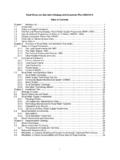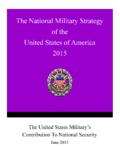Transcription of CYBERSECURITY STRATEGY - nisc.go.jp
1 Provisional Translation CYBERSECURITY STRATEGY September 4, 2015 Cabinet Decision The Government of Japan Contents 1. Introduction .. 1 2. Understanding on Cyberspace .. 3 B enefits of Cyberspace .. 3 Incre asi ng Thr eat s in Cyber space .. 3 3. Visions and Objective .. 5 4. Basic 8 Assurance of t he Free Flow of Informatio n .. 8 Th e Rul e of 8 Openn ess .. 8 Auto 9 Collaborat ion among Multi-st akehold 9 5. Policy Approaches towards Achieving the 11 Improving Socio-Economic Vitality and Sustainabl e Development ..12 Creation of Secured IoT Systems.
2 13 Promotion of Enterprise Management with a Security Mindset ..15 Improvement of CYBERSECURITY Business Environment ..18 B uildi ng a Safe and Secure Society for the People ..21 Measures for the Protection of the People and Measures for Critical Information Infrastructure Measures for the Protection of Governmental Ensuring Peace and Stability of the International Community and National Security ..35 Ensuring National Security ..36 Building Peace and Stability of the International Cooperation and Collaboration with Countries around the World ..41 Cross- Cutting Appro aches to CYBERSECURITY .
3 45 Advancement of R&D ..45 Development and Assurance of CYBERSECURITY 6. Promotion and Implementation of 52 7. Plan Process and 55 1 1. Introduction Since the late 20th Century, the world has irreversibly experienced revolutionary transformations. As Gutenberg s invention of letterpress printing induced the explosion of knowledge, the invention of computers and the Internet, followed by their widespread use, has enabled people to discuss and share thoughts throughout the world without geographic and time constraints. Composed of countless computers, sensors, and actuators that have been networked by information and communications technologies (hereinafter referred to as I CTs ), cyberspace has greatly expanded the activities of people in physical space.
4 The free and interactive exchanges of ideas and opinions in cyberspace, originated in digital messages and information sent from every part of the world, constitute the foundation of a global democratic society. Additionally, sparking a cascade of new business models and technological innovations, the digital space has become a frontier of economic growth. In this new sphere of cyberspace, however, malicious activities are prevailing. Stealing personal, business, and organizational information and assets has been increasingly persistent.
5 There are also growing threats against national safety and security; governmental bodies and business operators, which provide mission-critical infrastructure necessary for the people s daily lives and economic activities, have been exposed to cyber attacks that would risk their business operations and continuity. In light of such malicious activities, how to best counter these threats is a challenge to ensure and maintain the free flow of information that is the backbone of democracy, the safe and secure living environment of the people, economic and social prosperity, and peace, while protecting intellectual propertie s that are the fruits of the creativities and inspirations of individuals and business e s as well.
6 Under these circumstances, Japan enacted the Basic Act on CYBERSECURITY in November 2014. This Act prescribes the concept of CYBERSECURITY and defines the roles and responsibilities of the Government, local governments, and other relevant stakeholders; it also designates the CYBERSECURITY Strategic Headquarters as the command and control body of national CYBERSECURITY , and gives strong authorities, such as making recommendations to national administrative organs, to the CYBERSECURITY Strategic Headquarters. This mission document is to be formulated pursuant to the Basic Act that prescribes the Government s responsibility to establish the CYBERSECURITY STRATEGY .
7 Looking towards the Games of the XXXII Olympiad and the Tokyo 2020 Paralympic Games (hereinafter referred to as Tokyo 2020 ) and the prospects further ahead for 2 the early 2020s, this STRATEGY outlines the basic directions of Japan s CYBERSECURITY policies for the coming three years approximately. To the world, it articulates Japan s vision for cyberspace; and by implementing this STRATEGY , Japan w il l endeavor to ensure a free, fair, and secure cyberspace; and subsequently contribute to improving socio-economic vitality and sustainable development, building a society where people can live safe and secure lives, and ensuring peace and stability of the international community and national security.
8 To achieve this objective, the Government of Japan has laid out this STRATEGY as a platform for the common understanding and actions of relevant stakeholders. 3 2. Understanding on Cyberspace Benefits of Cyberspace Cyberspace is an artificial domain for the free exchange of ideas without being constrained by national borders; it is an intangible frontier of infinite values generated by intellectual creations and innovations inspired by the ideas globally exchanged. The private sector-led investment and the accumulation of wisdom have been pivotal to the rapid expansion of cyberspace; and, today, cyberspace is an essential foundation of Japan s socio-economic activities, as it has attracted a great deal of users due to its non-discriminatory and non-exclusive nature of easy accessibility.
9 On the other hand, the cyber diastrophism provoked by ICTs evolution is only in its initial stage. Recently, all kinds of things or physical objects, from persona l computers, home electric appliances, automobiles, to robots and smart meters, h a v e begun to be connected to networks including the Internet, benefitting from advanced hardware, such as sensor devices, the widespread of affordable and high-speed Internet, and the advancement of Big Data analytics technologies, and more. Along with the increasing connectivity, physical objects and people in real space have become interconnected in a multi-layered manner without physical constraints, by harnessing the free flow of information and accurate data communications in cyberspace.
10 Due to such linkages, there is an emergence of an interconnected and converged information society where physical space and cyberspace have become highly integrated. It is a society that enables the members of the society to create innovative services and to generate brand new values exponentially. A free and fair cyberspace is a prerequisite for benefitting from cyberspace, which is an enabler of the improvement of socio-economic vitality and sustainab l e development. Increasing Threats in Cyberspace While cyberspace has brought significant benefits to our lives, malicious activities to harm these benefits are increasing.






